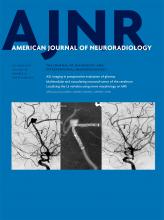We greatly appreciate the interest that Drs Lecler, Savatovsky, and Audren have shown in our recent article entitled “Trochlear Groove and Trochlear Cistern: Useful Anatomic Landmarks for Identifying the Tentorial Segment of Cranial Nerve IV on MRI,”1 and we are grateful for their thoughtful comments.
Multiple anatomic studies have independently documented the existence of the trochlear groove and trochlear cistern.2⇓⇓⇓–6 We observed these structures in our clinical practice on coronally acquired fluid-sensitive MR imaging performed routinely as a component of sinus MR imaging examinations at our institution. It has been our experience interpreting these clinical studies that the trochlear groove and trochlear cistern facilitate identification of the adjacent tentorial segment of cranial nerve IV.
This observation and subsequent clinical experience provided the motivation for our recently published study, which involved the retrospective review of 25 consecutive sinus MR imaging examinations containing the fluid-sensitive sequence of interest.1
Our primary interest was the anatomy. We did not mean to suggest that we had developed a novel MR sequence or that this routine clinical sequence represents the best possible one for identifying cranial nerve IV in its entirety. Rather, we hoped to share an imaging observation based on anatomic facts that we believed others may find useful in the assessment of cranial nerve IV pathology.
We would like to clarify the voxel size reported in our initial article because we now realize it to be a source of confusion that could have been stated more clearly. We intended for the reported voxel size range to indicate that the in-plane resolution of the coronally acquired sequence ranged from 0.3 × 0.35 to 0.4 × 0.44 mm and that the out-of-plane section thickness (in the anteroposterior dimension rather than the superior-inferior or z-axis dimension) was 3.0 mm. Because the tentorial segment of cranial nerve IV travels nearly perpendicular to coronally acquired sections through the trochlear groove and trochlear cistern, these acquisition parameters are in fact sufficient to identify cranial nerve IV in many (but not all) cases, as was shown in our study. Moreover, the tentorial segment of cranial nerve IV was often seen on multiple contiguous sections in our study, and we considered seeing the nerve on a single image to be insufficient for nerve identification.
Additionally, we would like to reiterate that we did not identify the entire intracranial course of cranial nerve IV but only the tentorial segment—the portion of the nerve that passes beneath the tentorium before entering the cavernous sinus. It has been our experience that this particular segment of cranial nerve IV is especially difficult to identify on axial images, including high-resolution cisternographic sequences (CISS, FIESTA, and so forth), and we consider this difficulty likely to be related to volume averaging of the overlying tentorium. Thus, we remain convinced that it is advantageous to leverage in-plane resolution and scan this particular segment of cranial nerve IV in the coronal plane perpendicular to its course.
Identifying the intracranial segments of cranial nerve IV in routine clinical practice remains difficult, and we are appreciative of the coregistration-fusion technique suggested by our colleagues. Indeed, we welcome any solution to the difficult problem of identifying cranial nerve IV throughout its course using clinically practical MR imaging, and we agree that the more proximal cisternal segment of cranial nerve IV is very nicely demonstrated in our colleagues' figure.
We look forward to further discussion and exchange of ideas.
References
- © 2017 by American Journal of Neuroradiology












